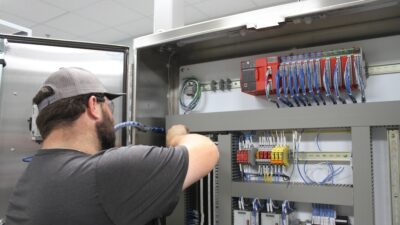Opto 22 says support for IEEE 802.11a, b, and g increases wireless design flexibility.
|
Opto 22 says support for IEEE 802.11a, b, and g increases wireless design flexibility. Learn more about how wireless and wired I/O technologies work together in an Opto 22 white paper . |
IEEE 802.11 wireless standards are supported by Opto 22, explains Ben Orchard, application engineer, who shared Opto 22’s wireless strategy with Control Engineering .
"Opto 22’s wireless technology (found in our PACs and I/O products) is based on the industry-standard IEEE-802.11 specification with support for a, b, and g networks that operate in the license-free 5 GHz (802.11a) and 2.4 GHz (802.11b/g) frequency bands. In this way the controllers and I/O brains can be used in the most common wireless infrastructures deployed in the world today.
"Wireless access points, wireless routers, and wireless repeaters from nearly any vendor can co-exist with Snap PAC wireless technology. The 5 GHz (802.11a) option is particularly significant-and unique in industrial I/O systems-because it allows users to deploy SNAP PAC wireless in a frequency other than the typically crowded 2.4 GHz band, where interference from other 2.4 GHz devices, such as microwave ovens, could reduce performance.
In addition, Orchard, mentioned, Opto 22 wireless products "offer the faster 802.11a and 802.11g radio technologies (54 Mbps), which differs from competing vendors’ products that use 802.11b only (11 Mbps)."
The wireless technologies offered from Opto 22 "provide numerous benefits to users, beginning with the significant savings achieved through the reduction in wiring and termination costs. Wireless networking also makes it possible to deploy I/O and controllers in remote areas, areas that are inaccessible, or areas where network wiring is difficult or impossible to install.
"Wireless capabilities in Opto 22 Snap PAC I/O and controllers are unique in the automation industry because most other industrial wireless networking solutions are separate from a vendor’s standard line of components. Users are often required to purchase different or additional components-such as special module carriers or custom wireless I/O modules, racks, and terminations-which in turn requires them to carry a separate inventory of spares and networking gear. In many cases, the full line of a vendor’s analog and digital I/O does not support wireless networking. As a result, customers are forced to choose wired or wireless up front, and thus specify and commit to a networking technology in the early stages of project design. Later, if wireless communication doesn’t meet needs or expectations-or vice-versa in the event they wish to wirelessly enable an existing application-they must procure, configure, and install different hardware," he says.
"In contrast, Opto 22’s Snap PAC controllers and I/O brains give users both wired and wireless at any time. They can network their components via standard wired Ethernet, use 802.11a/b/g for wireless networking, or use a combination of both," Orchard adds.
See also in Control Engineering , System Integration: Wireless Standards .
– Mark T. Hoske, editor in chief, Control Engineering , www.controleng.com




